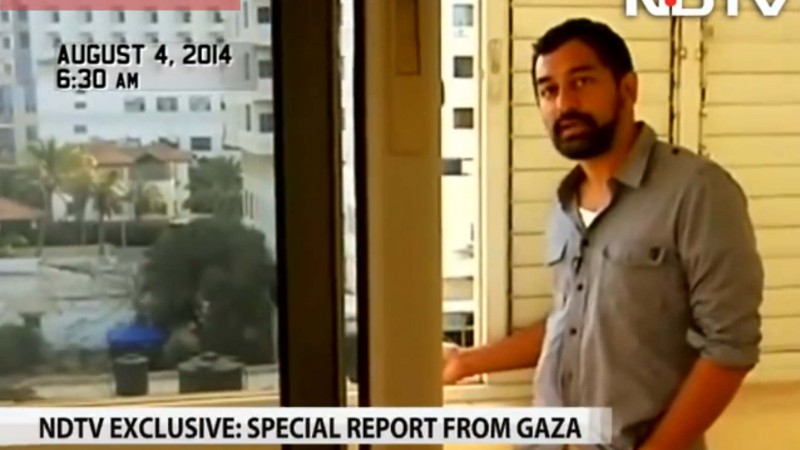A video report from NDTV showing Gazan militants firing a rocket towards Israel from within a residential area earned the Indian broadcaster attention around the world earlier this month. It was one of the first times throughout the now six-week-long bombardment of Gaza that a major news outlet had captured the assembly of a rocket launch site on film, and the footage was quickly touted by the Israeli government and its supporters.
Journalist Sreenivasan Jain and his crew, who happened to be staying at a hotel next to where the three men began to set up the launch site, published the report on Aug. 5 after they had left the strip. Two days later, Jain offered more backstory on the network's website and lamented how the story was being “distorted by the twin forces of internet virality and the Israel-Palestinian spin machine”:
Fairly soon after it aired, it was distressing to find that the story had become Israel's ‘I told you so’ moment, an independent endorsement proof. In their eyes, that the media has finally acknowledged Hamas's dubious military tactics (the video was shared on the Israel Defence Force's social media platforms; it was also featured as a brief clip at a Netanyahu press conference). In turn this provoked sharp reactions from (some of) those sympathetic to the Palestinian cause, who accused us of ‘betrayal’. Just four days back, they praised us for our report from Rafah in south Gaza where the hunt for a so-called missing Israeli soldier had unleashed carnage. (The IDF did not re-tweet or ‘like’ that report).
At least 2,000 Palestinians have been killed, more than 10,500 injured, and 520,000 displaced since Israel launched a massive offensive called Protective Edge against the 40-kilometer-long congested strip on July 8. Israel says the assault is targeting Hamas, a group that has ruled Gaza since 2007 under a seven-year blockade from Israel, for firing rockets across the border. Since the offensive started, three civilians have been killed in rocket attacks on Israel and 64 Israeli soldiers have been killed in fighting in Gaza.
NDTV's report made international headlines for filming what is a rare sight for journalists on the ground. There are conflicting reports of Hamas members intimidating journalists to prevent them from capturing scenes such as these, but New York Times photographer Tyler Hicks said after reporting for the first two weeks of the offensive in Gaza that this is “a war fought largely behind the scenes.” “If they were to even step a foot on the street they would be spotted by an Israeli drone and immediately blown up,” he said. “We don’t see those fighters. They are operating out of buildings and homes and at night.”
It also purportedly showed what Israel has long complained of — that Hamas fires rockets from civilian areas, putting innocent people in the line of Israeli retaliation. NDTV reported that the men assembling the rocket were members of Hamas, but Jain admitted in his follow-up that “absolute certainty is always hard to establish” in determining if the men were indeed Hamas militants. He said the rocket was one of many launched just before a 72-hour ceasefire came into effect, “suggesting the handiwork of the biggest, most-organized and well-stocked group on the Gaza Strip- Hamas.”
Other armed factions are operating in Gaza, such as the Palestinian Islamic Jihad and the Popular Resistance Committees, and have claimed responsibility for rocket attacks against Israel.
Jain emphasized that the report “in no way absolves the IDF from taking responsibility for the appalling toll its offensive has taken on civilian lives” and “in no way implies proportionality.” Seventy-two percent of Palestinians killed in this offensive have been civilians, according to the UN:
We know that compared to Israel's firepower, Hamas's rockets are a minor threat. Of the almost 3,600 fired so far, only 10% have posed a serious risk to Israel's cities and have been taken down by its Iron Dome response system. The rocket we saw, in all probability, must have been the one of the 1000s that landed in open areas. But by firing these rockets from civilian areas, they threaten the people of Gaza more than anyone else: that was the simple point of this report.
Srinivasan also took part in a live chat answering some of the questions from viewers.
In India, public sympathy is high for the heavy casualties in Gaza, but there is also a feeling that a country has the right to protect itself. The country's government has balanced its stance of supporting the Palestinian cause with maintaining good diplomatic relations with Israel. The NDTV report generated much discussion on India's social networks, especially in Twitter.
@smitabarooah @ndtv Balanced view? Precision guided missiles from air to burn sleeping children, sharpnels to blow their scalps of infants..
— Nancy Jha (@NancyJha) August 5, 2014
@rsarvesh12 @pritiriyer Hamas is a terror organisation. Interestingly out of all news channel it was NDTV which exposed them. #AccheDin
— Varun Sharma (@varun_sharma07) August 14, 2014
The sham that is Indian News is brought out by the fact that no channel, Hindi or English, has spoken of @ndtv‘s Hamas rocket launch story.
— Anand Ranganathan (@ARangarajan1972) August 6, 2014
Intriguing that NDTV has blurred the face of Hamas terrorists who have been captured firing rockets on Israel. Wonder why? @SreenivasanJain
— Akhilesh Mishra (@amishra77) August 6, 2014
An all-out information war has accompanied the actual war raging on the ground in Gaza and across Israeli skies, but as Jain himself wrote, just because a journalist fears their reporting could be used by propagandists doesn't mean they should self-censor it:
To let this fear cripple our work would amount to erasing the difference between journalism and propaganda.







